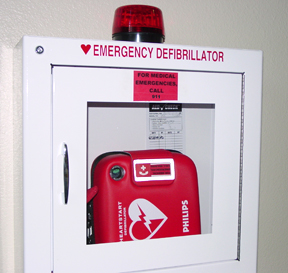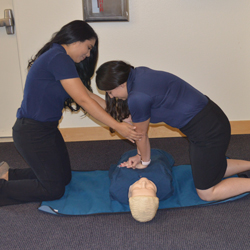Learn CPR
RCP Con Solo Compresiones de Pecho
RCP Con Solo Compresiones de Pecho- version corta
Learn CPR Powerpoint and Posters
Chest-Compression-Only CPR (CCO-CPR)
Data from the first intentional effort to encourage and endorse CO-CPR by lay individuals showed that survival rates for patients with out-of-hospital cardiac arrest are better when bystanders do CO-CPR, compared with CPR that calls for chest compressions interrupted by mouth-to-mouth “rescue breaths.” Sarver Heart Center’s Resuscitation Research Group published this Arizona data in the Oct. 6, 2010 issue of the Journal of the American Medical Association (JAMA), which validated the group’s decades of research and advocacy.
Frequently Asked Questions about Chest-Compression-Only CPR
How do you know if it’s primary cardiac arrest?
- The person is fine one moment and you suddenly see or hear them collapse.
AED Information and Instructions
 The most common reason for a sudden cardiac arrest is ventricular fibrillation, an arrhythmia that disrupts the heart’s ability to beat and pump blood. While chest-compression-only CPR pumps blood to the brain and other organs, a shock from an AED (automated external defibrillator) is necessary to restore the heartbeat if the device detects a “shockable” rhythm.
The most common reason for a sudden cardiac arrest is ventricular fibrillation, an arrhythmia that disrupts the heart’s ability to beat and pump blood. While chest-compression-only CPR pumps blood to the brain and other organs, a shock from an AED (automated external defibrillator) is necessary to restore the heartbeat if the device detects a “shockable” rhythm.
3 C's to Save a Life
Check… Call… Compress
in Cases of Sudden Cardiac Arrest
If you see someone collapse unexpectedly this is usually the result of cardiac arrest. Studies have shown that by doing chest compressions only, without mouth-to-mouth breathing, bystanders increase the person’s chance of survival. Follow these three steps to perform Chest-Compression-Only Resuscitation:
Gasping is a Sign of Cardiac Arrest
By Gordon A. Ewy, MD
SHARE Consortium and the UA Sarver Heart Center Resuscitation Research Group rediscovered a fact that cannot be emphasized enough, both to experts in the field of resuscitation science and to the public.
What does Primary Cardiac Arrest Look Like?
Primary cardiac arrest is recognized by a sudden, unexpected, witnessed (seen or heard) collapse in an individual who is not responsive. Patients with primary cardiac arrest often gasp (an abnormal snoring-like respiration) which provides adequate ventilation, but indicates a cardiac arrest. If chest-compression-only CPR is provided, the individual often continues to gasp, and in such patients assisted ventilations are not necessary for prolonged periods of time,” says Dr. Gordon A.


